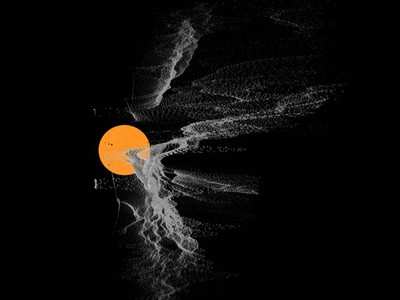New NASA Imagining System Allows View From All Sides
 NASA-funded scientists have created
the first three- dimensional (3-D) view of massive solar eruptions
called Coronal Mass Ejections (CMEs). The result is critical for a
complete understanding of CMEs, which, when directed at Earth, may
disrupt radio communications, satellites and power systems
NASA-funded scientists have created
the first three- dimensional (3-D) view of massive solar eruptions
called Coronal Mass Ejections (CMEs). The result is critical for a
complete understanding of CMEs, which, when directed at Earth, may
disrupt radio communications, satellites and power systems
The researchers analyzed ordinary two-dimensional images from
the joint NASA/European Space Agency Solar and Heliospheric
Observatory (SOHO) spacecraft in a new way to yield the 3-D
images.
"We need to see the structure of CMEs in three dimensions to
fully understand their origin and the process that launches them
from the sun," said Dr. Thomas Moran of the Catholic University of
America, Washington. "Views in three dimensions will help to better
predict CME arrival times and impact angles at the Earth," he
said.
Moran developed the analysis technique. He is lead author of a
paper on this research published today in Science. Dr. Joseph
Davila of NASA's Goddard Space Flight Center, Greenbelt (MD), is
co-author of the paper.
CMEs are among the most powerful eruptions in the solar system,
with billions of tons of electrified gas being blasted from the
sun's atmosphere into space at millions of miles (kilometers) per
hour.
Researchers believe CMEs are launched when solar magnetic fields
become strained and suddenly "snap" to a new configuration, like a
rubber band that has been twisted to the breaking point. Complex
and distorted magnetic fields travel with the CME cloud and
sometimes interact with the Earth's own magnetic field to pour
tremendous amounts of energy into the space near the planet.
The magnetic fields are invisible, but because the CME gas is
electrified (a plasma), it spirals around the magnetic fields,
tracing out their shapes. A view of the CME gas in 3- D therefore
gives scientists valuable information on the structure and behavior
of the magnetic fields powering it.
The new analysis technique for SOHO data determines the
three-dimensional structure of a CME. A sequence of three SOHO
Large Angle and Spectrometric Coronagraph (LASCO) images is taken
through polarizers at separate angles. The ratio of
polarized-to-unpolarized brightness at each pixel is then computed.
Based on the way light scatters off electrically charged particles
(electrons) in CME plasma, light from the structures at angles
closer to the plane-of-the-sun will be more polarized than light
from those at angles farther from the plane.

The distance from the plane is computed from the measurements,
giving the three-dimensional coordinates of the mean scattering
position to construct a view in 3-D. (Light which has an electric
field oriented randomly in all directions is unpolarized, while
light with an electric field oriented in just one direction is
polarized.)
With the technique, the team has confirmed that the structure of
Earth-directed (halo) CMEs is an expanding arcade of loops, rather
than a bubble or rope-like structure. Although the CME eventually
disconnects from the sun, the team also discovered the loops
remained connected to the source region for an unexpectedly long
time, for at least as long as the CME was visible to the SOHO
instrument.
The team learned the technique was previously independently
developed and used to study relatively static structures in the
solar atmosphere during total solar eclipses. The team believes its
method will complement the upcoming Solar Terrestrial Relations
Observatory (STEREO) mission. The mission, scheduled for launch in
February 2006, will use two widely separated spacecraft to
construct 3-D views of CMEs by combining images from the two
different vantage points of the twin spacecraft.
 ANN's Daily Aero-Linx (04.15.24)
ANN's Daily Aero-Linx (04.15.24) Classic Aero-TV: 'No Other Options' -- The Israeli Air Force's Danny Shapira
Classic Aero-TV: 'No Other Options' -- The Israeli Air Force's Danny Shapira Aero-News: Quote of the Day (04.15.24)
Aero-News: Quote of the Day (04.15.24) Airborne 04.16.24: RV Update, Affordable Flying Expo, Diamond Lil
Airborne 04.16.24: RV Update, Affordable Flying Expo, Diamond Lil ANN's Daily Aero-Term (04.16.24): Chart Supplement US
ANN's Daily Aero-Term (04.16.24): Chart Supplement US




